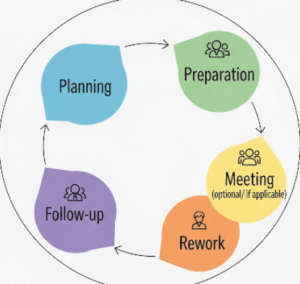- Metrics for Process and Products
- Software measurement
- Metrics for Software Quality
- Risk Management
- Reactive versus Proactive Risk Strategies
- Software Risks
- Risk Identification
- Risk Projection
- Risk Refinement
- RMMM
- RMMM Plan
- Quality Management
- Quality Concepts
- Software Reviews
- Formal Technical Reviews
- Statistical Software Quality Assurance
- Software Reliability
- The ISO 9000 Quality Standards
Introduction to Software Reviews
In software engineering, software reviews are fundamental quality control activities. These systematic examinations of software artifacts – which can include requirements, design documents, source code, or test plans – are conducted by individuals or a team other than the author. The primary objective of software reviews is to identify and remove errors as early as possible in the software development lifecycle. By proactively catching defects, software reviews significantly enhance product quality, reduce development costs, and prevent small issues from escalating into major problems later in the project. They represent a critical gatekeeping function for quality.
The Importance of Software Reviews
Software reviews play a pivotal role in achieving and maintaining high software quality for several compelling reasons:
- Early Defect Detection: Errors found during review stages (like requirements or design reviews) are significantly cheaper and easier to fix than those discovered during testing or, worse, after deployment. This saves considerable time and resources.
- Improved Product Quality: By systematically identifying and correcting defects, reviews directly contribute to a more robust, reliable, and higher-quality final software product.
- Knowledge Transfer: Reviews serve as an excellent mechanism for knowledge sharing among team members. Reviewers gain insight into different parts of the project, and authors receive constructive feedback.
- Standard Adherence: Reviews help ensure that software artifacts comply with established coding standards, design principles, and organizational guidelines.
- Reduced Rework: Catching errors early means less rework is needed in later, more expensive phases of development.
- Enhanced Communication: The review process often fosters better communication and collaboration within the development team, leading to a more shared understanding of the project.
Types of Software Reviews
While formal technical reviews are a prominent type, software reviews encompass a spectrum of approaches, varying in their formality and objectives. These various types serve different purposes throughout the development lifecycle.
Informal Reviews
Informal reviews are less structured and might involve a quick desk check by a peer or an ad-hoc meeting to discuss a section of code or a document. They are quick, provide immediate feedback, and are good for catching obvious errors.
Walkthroughs
A walkthrough is a review meeting where the author of a software artifact (e.g., code, design) presents it to a small group of peers. The purpose is to allow the reviewers to ask questions, point out potential errors, and improve understanding. It’s more interactive than a desk check but less formal than an inspection.
Inspections (Formal Technical Reviews – FTRs)
Inspections are highly structured and formal software reviews. They are often referred to as Formal Technical Reviews (FTRs) due to their rigorous nature. These involve a trained team systematically examining software artifacts against a checklist of common error types. The focus is purely on defect detection, not problem-solving or education, making them very efficient at finding errors.
Pair Programming
While not a review in the traditional meeting sense, pair programming can be considered a continuous form of informal code review. Two developers work together at one workstation, with one writing code and the other continuously reviewing it. This real-time review often catches errors as they are being made.
Code Reviews
Specific reviews focused solely on source code. These can range from informal peer checks to more formal tools-assisted or structured inspections. The goal is to ensure code quality, adherence to standards, and identification of logical errors.
The Review Process (General Steps)
Regardless of the specific type, most software reviews generally follow a set of common steps:
- Planning: Defining the scope, objectives, and participants for the review.
- Preparation: Reviewers individually examine the work product for defects before the meeting.
- Meeting (if applicable): A structured discussion where defects are identified and logged. The author presents, and reviewers raise concerns.
- Rework: The author uses the identified defects and feedback to correct and improve the work product.
- Follow-up: Verification that all identified defects have been correctly addressed and that the necessary changes have been implemented.

Challenges in Software Reviews
While highly beneficial, conducting effective software reviews can face certain challenges:
- Time Commitment: Reviews require a significant investment of time from multiple team members.
- Human Factor: The effectiveness of reviews heavily depends on the skill, focus, and objectivity of the reviewers.
- Emotional Resistance: Authors might feel sensitive to criticism, which can hinder the constructive nature of reviews.
- Lack of Training: If reviewers are not properly trained in review techniques, the process might be inefficient.
Despite these challenges, the benefits of systematic software reviews in terms of improved quality and reduced costs typically far outweigh the difficulties.
Conclusion
Software reviews are an indispensable practice within quality management, serving as a powerful mechanism for detecting and eliminating defects early in the software development lifecycle. By systematically examining software artifacts through various approaches, from informal walkthroughs to highly structured inspections, teams can significantly enhance product quality, reduce rework, and ensure adherence to standards. Embracing a culture of thorough software reviews is crucial for building reliable, maintainable, and successful software systems.
